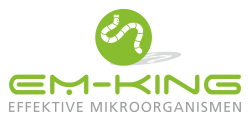Ecological Gardening with Effective Microorganisms

Garden Care with Effective Microorganisms: A Natural Approach for Lush Plant Growth
Garden care is a valuable hobby for many people and also a way to enjoy nature while actively relaxing. There are numerous methods and approaches to cultivating healthy, resilient plants. One particularly sustainable and effective method is the use of Effective Microorganisms (EM). These natural helpers play a crucial role in making soils more fertile, promoting plant growth, and controlling pests in an environmentally friendly way.
What Are Effective Microorganisms (EM)?
Effective Microorganisms (EM) are a blend of various beneficial microorganisms that already exist in nature. They consist of lactic acid bacteria, yeasts, and photosynthetic bacteria that work together in a sophisticated balance to increase soil fertility and improve plant growth. Through their positive effects on soil microbiology and the organisms living within, they contribute to a natural, chemical-free balance in the garden.
The Benefits of EM in Garden Care
-
Improving Soil Quality: EM break down organic matter more quickly and efficiently, resulting in humus—a vital component of healthy soils. Humus stores nutrients and water better, benefiting plants while reducing water consumption in the garden.
-
Promoting Plant Growth: By enhancing the soil, Effective Microorganisms make essential nutrients available to plants. They help convert nutrients like nitrogen and phosphorus into forms that plants can easily absorb.
-
Suppressing Pathogens: EM can also inhibit the growth of harmful microorganisms in the soil. This reduces the risk of plant diseases and decreases the need for chemical pesticides. Thus, a healthy garden environment is created where plants can thrive.
-
Environmentally Friendly and Sustainable: Effective Microorganisms provide a natural solution to many challenges in gardening. They help reduce the use of synthetic fertilizers and pesticides, which benefits not only the plants but the entire ecosystem. This allows soils to regenerate and remain healthy over the long term.
Using EM in the Garden
Applying EM in the garden is simple and can be done in various ways. They can be dissolved in water and sprayed on the soil or directly worked into the ground. It is important to follow the recommended concentration and frequency of application for the best results.
- Soil Treatment: Spray an EM solution directly onto the soil or pour it over the roots of your plants. This improves soil structure and promotes root growth.
- Compost Treatment: EM can also be used to speed up composting processes. The resulting compost is rich in nutrients and microorganisms that benefit the soil and plants.
- Leaf Treatment: Plants can additionally be sprayed with a light EM solution to improve leaf health and reduce the risk of diseases.
The Use of EM in Indoor Plant Cultivation
In addition to traditional outdoor garden care, Effective Microorganisms are also highly beneficial in indoor plant cultivation. Especially in a grow tent, which is designed for the controlled cultivation of plants indoors, EM can demonstrate their full potential.
A grow tent is a sealed environment where optimal growing conditions are created for plants. It provides an ideal space for growing herbs, vegetables, or ornamental plants, particularly in urban areas or homes without gardens. With the help of lighting, ventilation, and humidity control, plants can be grown under ideal conditions.
The Benefits of EM in a Grow Tent
-
Improved Soil Quality: Soil quality is just as crucial for success in a grow tent. By using EM, the microbiology of the substrate is optimized, leading to better nutrient uptake and healthier plant growth.
-
Natural Disease Control: In a closed system like a grow tent, imbalances in the microflora can easily occur, promoting the growth of pests and diseases. EM help maintain this balance and suppress harmful microorganisms.
-
Promoting Root Growth: Healthy root development is especially important in indoor cultivation, as space for the plants is limited. EM support root growth by improving the structure of the growing medium and providing essential nutrients to the roots.
-
Odor Neutralization: Another benefit of EM in indoor cultivation is their ability to neutralize unpleasant odors that can arise from the decomposition of organic materials. This ensures a pleasant indoor climate, especially when growing plants in enclosed spaces.
Conclusion
Using Effective Microorganisms in garden care offers numerous advantages, both outdoors and indoors. They not only promote plant growth and improve soil quality but also contribute to sustainable and environmentally friendly garden maintenance. When combined with a grow tent, gardeners can cultivate healthy, robust plants even in limited spaces. Regular use of EM creates a natural balance that leads to long-term success in gardening and plant cultivation.


